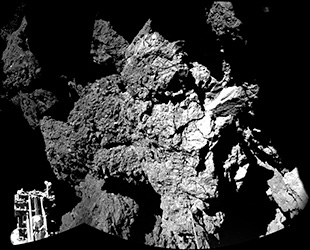Nov. 14, 2014 — "I'm feeling a bit tired, did you get all my data? I might take a nap..."
And with that, the European Space Agency's (ESA) Philae lander, the first probe to land on a comet, went to sleep.
The status update, posted on Twitter by its mission team on Friday evening (Nov. 14), signaled the likely end for the probe. With its batteries depleted and not enough sunlight reaching its solar panels to recharge, the Philae lander fell into an "idle mode," with all of its science instruments and most of its systems shut down.
"[It] performed magnificently under tough conditions, and we can be fully proud of the incredible scientific success Philae has delivered," said Stephan Ulamec, the lander's manager, from the European Space Operations Center in Darmstadt, Germany.
Contact with Philae was lost at 7:36 p.m. EST (0036 GMT Nov. 15), shortly before communications were expected to cut off as the probe's parent spacecraft and relay to Earth, Rosetta, flew below the horizon of Comet 67P/Churyumov-Gerasimenko's horizon.

The European Space Agency's Philae lander returned this image from the surface of Comet 67P/Churyumov-Gerasimenko. (ESA) |
"My life on a comet has just begun, Rosetta. I will tell you more about my new home, Comet 67P soon... zzzzz," the lander "wrote" on Twitter.
But no further contact will be coming unless more sunlight falls on Philae's solar panels to generate enough power to recharge its batteries to wake it up.
After touching down on the comet Wednesday (Nov. 12), the three-legged spacecraft bounced twice as the result of its landing thruster and harpoons failing to fire. It came to rest in the shadow of a cliff, which mostly blocked the sun from shining on its solar panels.
In an last-ditch attempt to improve the lander's chances, mission controllers on Friday sent commands to rotate its body, to which the solar panels are fixed. The hope is that the maneuver may expose more of the panels to sunlight.
"There is some hope that at some stage when we're closer to the sun that Philae wakes up again," Ulamac said. "But we need to be very lucky that this happens."
Before falling silent, Philae relayed all of its science data to Rosetta for transmission back to Earth. The information may include the analysis of the first samples collected by the lander's drill, which was activated on Friday.

Rosetta’s OSIRIS narrow-angle camera captured this parting shot of the Philae lander after the two probes separated. (ESA) |
The data may include the signs of water and organics that could have given rise to life on Earth, a major objective of the mission.
That goal will go on even if the lander is never heard from again. Rosetta will continue to study the comet from orbit as the icy-rocky body continues on its journey toward the sun. Rosetta is expected to continue observations through the end of 2015.
"S'ok Philae, I've got it from here for now," Rosetta "wrote" on Twitter Friday.
The orbiter will continue to listen for a signal from Philae, even though the chance of re-contact is slim.
"We can only hope that as we approach the sun, maybe in August if we do not have too much dust or a huge coma blocking the sun, perhaps there would be a chance that at some point we could come back and at least see how the lander's doing," said Valentina Lommatsch, a member of the lander control center team in Cologne. "So cross your fingers, or press your thumbs if you are German, perhaps we will hear something from the lander again."
